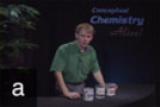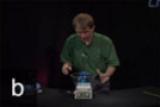Conceptual Physics
Chapter 18: Thermodynamics
The hotness of a material is related to the average kinetic energy of the submicroscopic particles within that material. In general, the hotter the material, the greater the average kinetic energy of its particles. We say "average" kinetic energy because the particles are all moving at different speeds--some fast some slow. Duration: 1:40.
Temperature is best judged using some external reference, such as the expansion or contraction of a liquid. Two temperature scales, the Celsius and Fahrenheit, are demonstrated. Duration: 6:06
The story of the tailor of Celsius is used to illustrate the need for the Kelvin temperature scale. This absolute scale is then compared with the Celsius and Fahrenheit scales. Duration: 8:16
Watch these additional videos to complete this tutorial.
Table of Videos
- Chapter 1: About Science
- Chapter 2: Newton's First Law
- Chapter 3: Linear Motion
- Chapter 4: Newton's Second Law
- Chapter 5: Newton's Third Law
- Chapter 6: Momentum
- Chapter 7: Energy
- Chapter 8: Rotational Motion
- Chapter 9: Gravity
- Chapter 10: Projectile and Satellite Motion
- Chapter 11: The Atomic Nature of Matter
- Chapter 12: Solids
- Chapter 13: Liquids
- Chapter 14: Gases
- Chapter 15: Temp, Heat, and Expansion
- Chapter 16: Heat Transfer
- Chapter 17: Change of Phase
- Chapter 18: Thermodynamics
- Chapter 19: Vibrations and Waves
- Chapter 20: Sound
- Chapter 21: Musical Sounds
- Chapter 22: Electrostatics
- Chapter 23: Electric Current
- Chapter 24: Magnetism
- Chapter 25: Electromagnetic Induction
- Chapter 26: Properties of Light
- Chapter 27: Color
- Chapter 28: Reflection and Refraction
- Chapter 29: Light Waves
- Chapter 30: Light Emission
- Chapter 31: Light Quanta
- Chapter 32: The Atom and the Quantum
- Chapter 33: The Atomic Nucleus
- Chapter 34: Nuclear Fission and Fusion
- Chapter 35: Special Theory of Relativity
- Chapter 36: General Theory of Relativity



